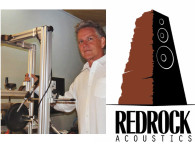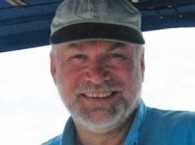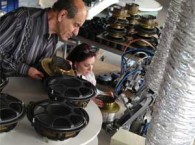
Innovator Continues to Test the Limits of Kable
SHANNON BECKER: Tell us a little about your background and where you live.
RAY KIMBER: I live in Roy, UT, a suburb of Ogden, UT. I have always been interested in electronics and audio. In 1955, as a 5 year old, I built a crystal radio kit with help from my father. Then, without any help or permission from my father, I “borrowed” his pair of army surplus communication headphones. Next, I “borrowed” uninsulated craft wire from my mother’s hobby box—and for insulation, adhesive bandage tape from the medicine cabinet—and wired it into the crystal set. My father worked as an appliance and electronics repairman, so the kitchen table was always filled with projects and test equipment. I was always right there “helping.” The crystal radio kit is long gone now—the victim of too many modifications—but I wanted to be like my dad. So, my interest in audio and electronics, along with my childhood “technical phase,” carried into elementary school, scouting, church, junior high, and high school.
SHANNON: How and when did you start experimenting with audio electronics?
RAY: Thank goodness for a rich(er) uncle who had a tape recorder in the 1950s. I was enamored with it. And while I was still in grade school, my father would give me unfixable electronics to tinker with (he supervised the application of power). I literally used baling wire (my grandparents were farmers) to graft a tone arm from one phonograph to another one that had a working motor. During high school I became acquainted with the owner of The Hi-Fi Shop in Ogden. The store carried McIntosh, JBL, Fisher, Dynaco, Thorens, Revox, Shure, Rabco, Ortofon, Sony, and TEAC equipment, among others. He also owned KBOC, a stereo FM radio station—I was in heaven. I worked as a DJ, and I built dozens of kits for his customers.

SHANNON: How did your company Kimber Kable come about?
RAY: In the mid-1970s, I was working as an engineer with a professional audio company in Los Angeles, CA. We had started to design and install equipment in large dance clubs, along with existing studio and commercial projects, and there was a problem with noise. With the advent of disco, the speaker cable was in close proximity to the flashing lights, strobe lights, and neon. Placing the speaker cable in a conduit or other shielding created other problems. I was stumped until I visualized a solution that had the conductors twisting in opposite directions, but with two conductors that wasn’t possible. Then, I remembered a Scout craft called Boondoggle. I promptly went to Yale Radio in Hollywood, purchased hook-up wire, and days later had some hand-braided speaker cable. I fully expected it to reject noise, what I wasn’t prepared for was the obvious difference in sound. Events brought me back to Utah where I pursued the idea.

SHANNON: What types of products/services does Kimber Kable provide?
RAY: We offer a complete line of speaker cables, analog and digital interconnects, video cables, and power cords. All our products share a familial design structure, but each was designed as a unique “problem solver.” Our goals of great products, performance, and value would not be nearly as compelling without the great service and knowledge of the individuals who’ve made the company possible. Wattgate, WBT USA, IsoMike, and Heatshrink.com are companies under the Kimber Kable umbrella.
SHANNON: In the past 33 years, how has Kimber Kable evolved? What has been your greatest achievement thus far?
RAY: It might be the nontechnical achievement of providing a stable gratifying business for our employees, vendors, and customers.

SHANNON: Can you tell us about your IsoMike demonstrations? How did you start doing them? What do the demonstrations entail? What type of equipment do you use?
RAY: The IsoMike sprang from some curiosity I had regarding series crossovers for loudspeakers. I was curious about how large a space between two microphones would be required before “flanging” would drop to inaudibility if the two microphones were mixed together at the same gain. I then repeated the same experiment but I used gain differential as the factor. Using a sine wave, it turned out to be about a 10’ separation or about 10 dB of differential. However, when using a complex tone, that spacing requirement jumped to about 20’ or about 20 dB. I then concluded that unless a single-point microphone scheme was used, that 20’ plus of separation lowered the flanging effect. But microphones spaced so widely apart would never sound right on a speaker playback (actually they would sound very right and very left, with no center image). Hmmm, I wondered how to make the microphones “think” they were spaced wider than they actually were. I hit on the notion of spacing the microphones at what I considered to be a good width for speaker playback, about 5’ or 6’, and then developing an absorptive asymmetrical baffle to isolate them.
SHANNON: What do you think is the key to sound done right?
RAY: Attention to every detail. You must understand the cost and benefit to each choice in a system. The ability to use both perceived and measured evaluations is also important.

SHANNON: What do you see as some of the greatest audio innovations of your time?
RAY: Radio frequency bending of cabinet materials, cast cabinet materials, astonishingly insightful test and measurement equipment, and direct-stream digital (DSD) have made audio great. Let me use two companies as examples, one relatively under-the-radar and one very well known. Merging Technologies provided the ability to record, edit, and master in DSD and digital eXtreme Definition (DXD). And, Sony for regaining the passion of design and manufacturing in its new SS-AR series of speakers. Audio innovations are great, in part, because of small companies like Merging Technologies with truly great products and Sony, a gigantic company that still has the ability to show soul.
SHANNON: Can you recommend any useful new parts or promising technologies? Is there anything you’re currently using that you think readers should know about?
RAY: The newest generation of DACs are delivering greater fidelity for the dollar, and I am delighted that some of them work in DSD. DSD downloads are gaining ground, we have plans to use the service from Blue Coast Records for our IsoMike downloads. And it warms my heart to see new entries in the turntable, cartridge, and phono preamp lineup. Headphones and the associated headphone amplifiers and portable DACs are also enjoying increasing popularity. aX






